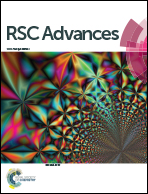Size dependence and UV irradiation tuning of the surface potential in single conical ZnO nanowires†
Abstract
Investigating and tailoring surface potential changes of a system at the interfaces is of significance in the fundamental understanding and application of semiconductor devices. Thus the surface potential of zinc oxide (ZnO) nanowires is a vital factor to tune the performance of devices. In this paper, Kelvin probe force microscopy (KPFM) is used to measure the surface potential of single conical ZnO nanowires with different diameters. A size dependence of the surface potential in single conical ZnO nanowires is experimentally revealed. As the diameter decreases, the surface potential of the ZnO nanowires is found to decrease linearly under 400 nm. At large diameters (≥400 nm), the surface potential remains almost constant. The contact potential difference of the ZnO–PtIr tip increases to saturation after 40 min UV illumination and remains stable. An energy band theory is introduced to explore the surface potential change of ZnO nanowires under UV illumination. This study provides an understanding of the surface electrical properties of semiconductors at the nanoscale, which is valuable for optimizing functional nanodevices based on semiconductor nanowires.


 Please wait while we load your content...
Please wait while we load your content...